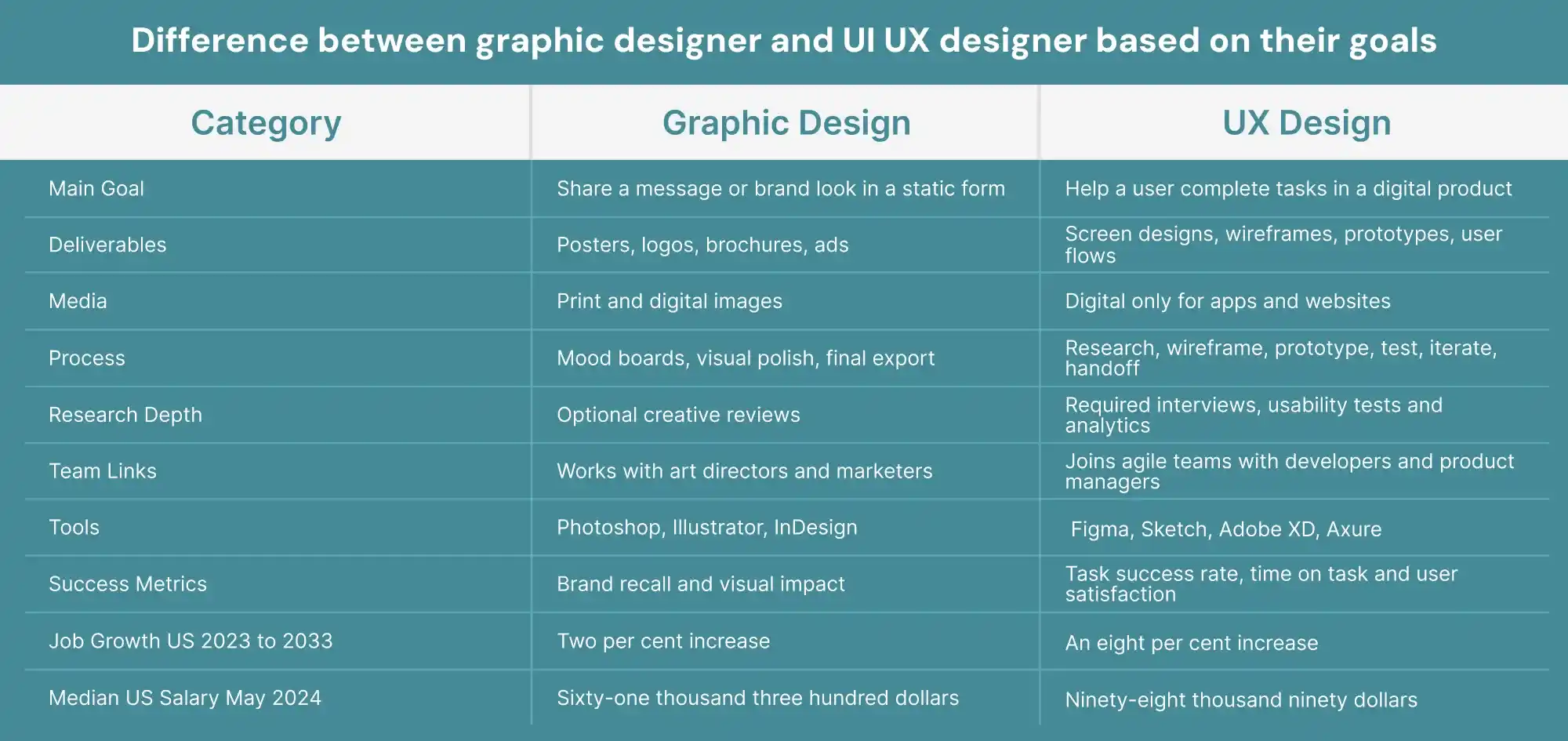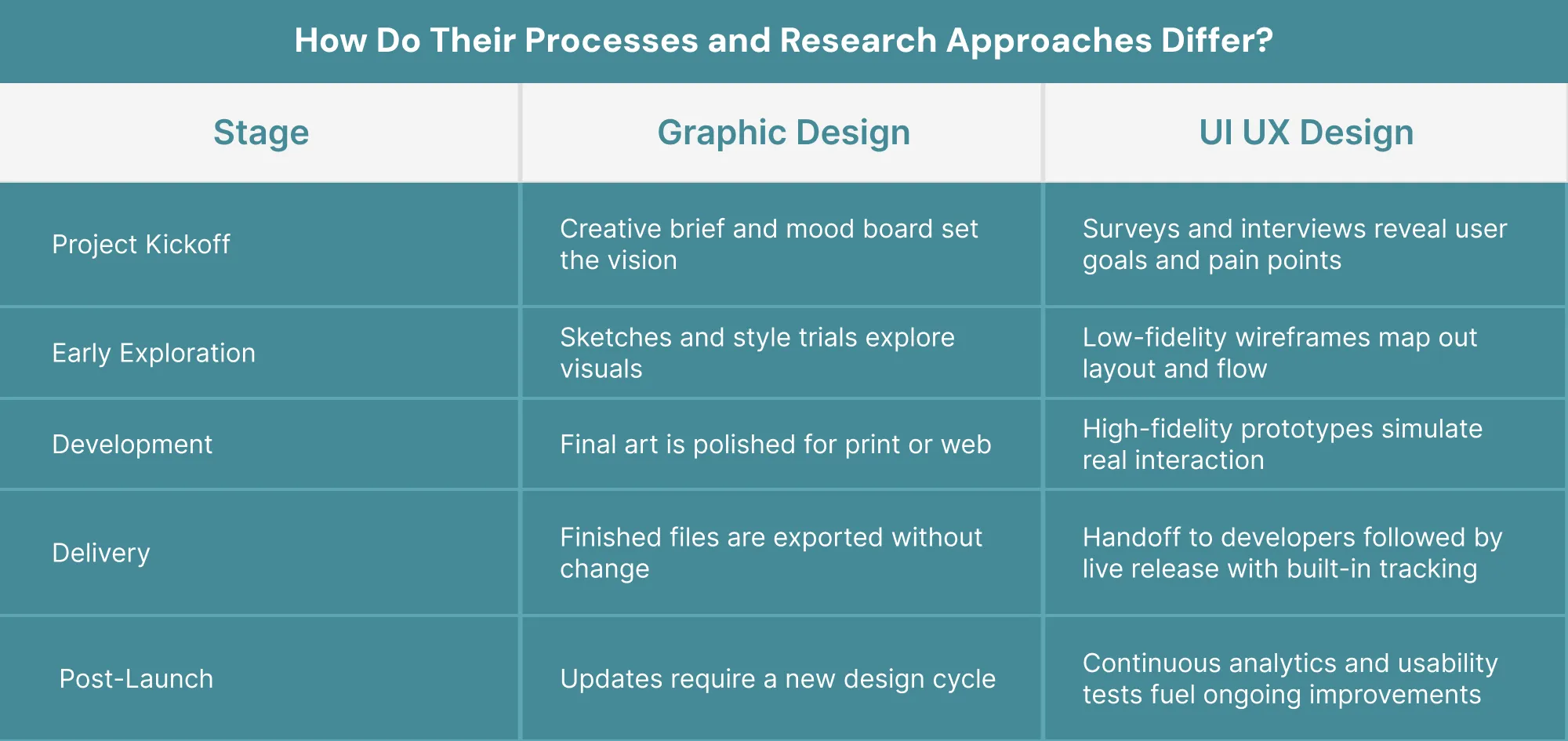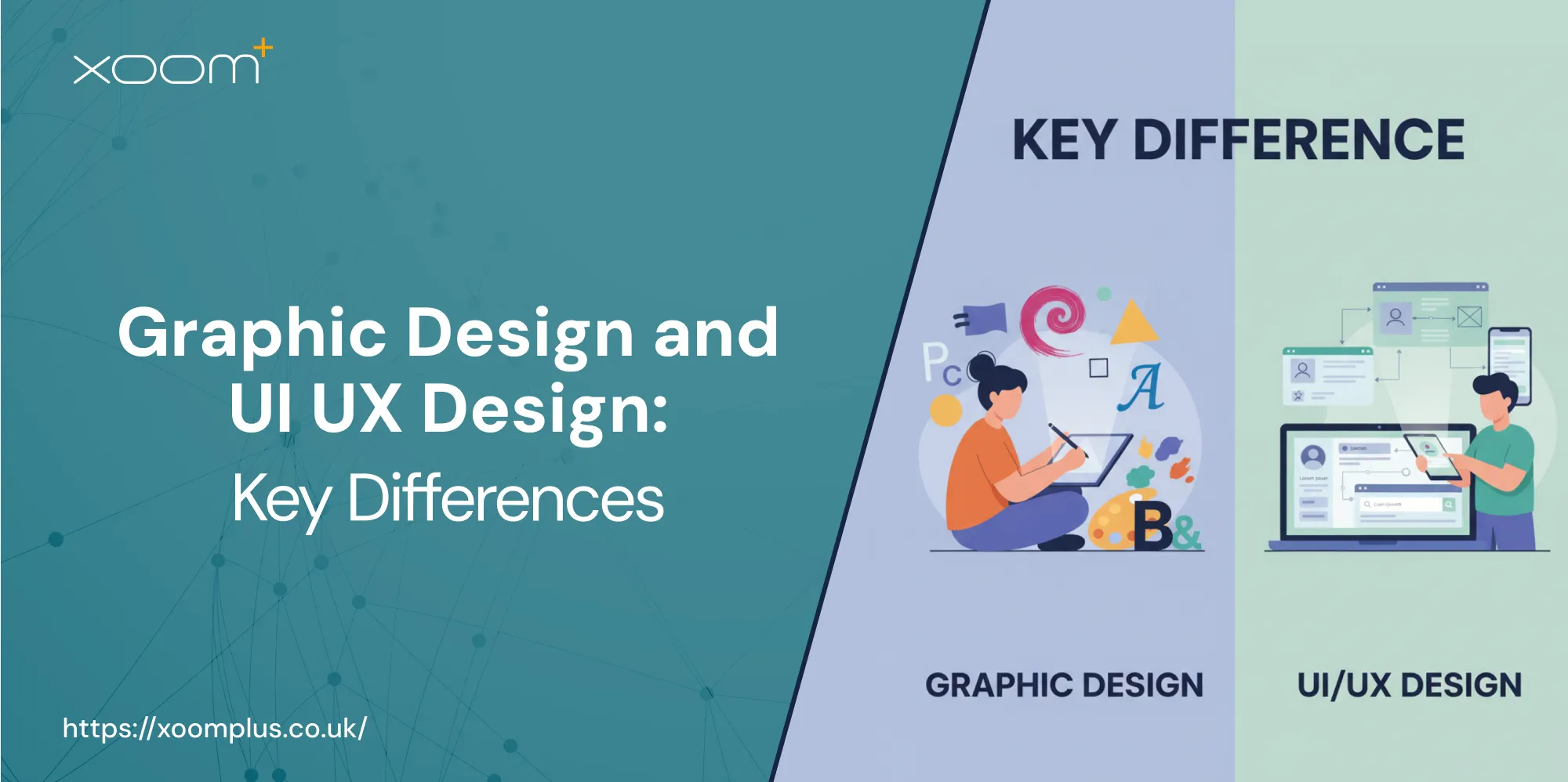- October 3, 2025
- Categories: Graphic Design Solutions
How Graphic Design Differs from UI UX Design
Have you ever encountered job posts while scrolling that use graphic design and UI UX design interchangeably? This might have led you to think they are the same thing; well, they are not. The debate of graphic design and UI UX design runs even deeper than colour palettes and screen layouts. Graphic designers are people who spend hours perfecting static designs, such as logos or posters, so they can capture maximum attention. UX designer, on the other hand, makes sure that the shopping journey to check out is seamless. In this blog, we will cut through any confusion that you have between the roles of graphic designer vs UI UX designer.
Understanding Graphic Design
Graphic design involves the creation of visuals that tell a brand story. These visuals are detailed with colours, shapes, textures and images that share a message that is clear and attractive. These also involve appropriate text that goes with the images and shapes.Why Graphic Design Matters
The main goal of graphic design is to create a strong brand identity. At a glance, your audience should know that this poster, post or logo is your company’s. Think of KFC, wherever you see red and fried chicken, you immediately recognise it is KFC. Basically, your visuals quickly show people what your brand is and what it stands for.Everyday Examples of Graphic Design
Graphic design is spread everywhere around you if you look closely. Here are some examples:- Logos on apps or products
- Posters or flyers in the streets or schools
- Graphics on websites or social media posts
- Packaging on toys or tech gadgets
Tools of the Trade
Graphic designers often use the following tools, and their purposes are listed along with them:- Adobe Photoshop for editing photos
- Adobe Illustrator for logos and illustrations
- Adobe InDesign for magazines and brochures
- Procreate for digital drawing on tablets
Understanding UI UX Design
The Difference Between UI and UX
People often think of UI and UX as the same thing, but they aren’t. They work together to make digital products fun to use. User experience, or UX design, looks at the entire journey a person takes with a product. Every click, tap and scroll is in scope. User interface or UI design shapes how each button, icon and screen looks and behaves.Everyday Examples of UI/UX Design
UI/UX design is aimed at the following kinds of products:- Wireframes that outline page layouts
- Prototypes to test how a design works
- User journey maps showing how people move through an app or site
- Design systems with colours and other components for consistency
Tools of the Trade
UI/UX designers usually use modern tools for their work. Here are some of them:- Figma for collaborative design and prototyping
- Sketch for creating digital interfaces
- Adobe XD for wireframes and prototypes
- Balsamiq for quick, low-fidelity wireframes
Graphic Design and UI UX Design: Key Differences
Here are some key differences in graphic design and UI UX design:-
Scope & Medium of Graphic Design and UI UX Design
Graphic Designer
Graphic designers work across digital media and print media. Logos, packages, billboards, everything falls in their domain. About 40-45% of the graphic design projects still involve print materials such as books and magazines. The rest focus on digital branding, such as website banners and social posts. This depicts that graphic design exists in the realm of physical advertising as well as digital media.UI/UX Designer
On the contrary, UI/UX design is purely digital. UI/UX designers work to create apps, software interfaces, or websites. Think of a travel app project. UX designers would sketch a user’s journey from searching flights to booking tickets. Similarly, a UI designer will work in detail on how the search bar, the buttons and the colour are going to look. So, unlike graphic design, all of this is only going to be on digital platforms.-
Purpose & Goals
Graphic Designer
The goal of graphic design is to communicate a message visually. It is supposed to build a strong brand identity. Logos need to remind you of the company immediately, while posters should be convincing enough that you book an event or buy a product on a whim. Around 65% of the customers state that colour influences purchase decisions. This shows how visual design can be a powerful driver for behaviour.UI/UX Designer
The goal of UI/UX design is very different. It is not just about being aesthetically pleasing. It has to work really well to be considered great, like making digital experiences smooth and functional. For instance, in onboarding processes, the time for sign-up can be considered a good metric for how good a UX design is. If people struggle or drop off, the design is then tweaked until the task feels effortless. This table highlights the difference between graphic designer and UI UX designer based on their goals.
-
Static vs Interactive: Graphic Design and UI UX Design
-
Tools & Collaboration of Graphic Design and UI UX Design
Tools for Graphic Design
Photoshop
Photoshop is a great tool that graphic designers can use for editing pictures. They can work in layers to adjust colours, or fix errors or blend images. It lets you choose multiple sizes for web or print in a single file. Photoshop guarantees that the design will always be of excellent quality, regardless of whether it is intended for printing or online release.Illustrator
Illustrator handles vector art for logos, icons and illustrations. It uses paths and shapes that help you retain quality. It helps designers use symbols and graphics that keep brand components consistent. As a result, your packaging, web pages and billboards are recognisable from afar.InDesign
InDesign is made for multi-page layouts such as magazines or reports. Master pages and style sheets keep text and graphics uniform. You can check for missing fonts or low-resolution images before export. The app lets you create print-ready PDFs or interactive digital documents.Tools for UI UX Design
Figma
Figma has changed how teams work in graphic design and UI UX design. It is a cloud-based tool where many people can edit the same file at once. Designers link screens into interactive prototypes and share them for feedback. Developers inspect code snippets and redlines directly from the canvas.Sketch
Sketch offers a clean interface for screen design. Shared styles and symbols keep colours, text and spacing uniform. A rich plugin library adds extra features like data population and version backups. Stakeholders can view prototypes in Sketch Cloud without installing software.Adobe XD
Adobe XD brings design and prototyping under one roof. You draw screens, define interactions and preview animations all in one app. Auto-animate links artboards to create smooth motion. Responsive resize adjusts elements when the screen size changes.Axure
Axure is for deep prototyping with logic and data. Designers build adaptive views that respond to screen size. You can add forms, tables and interactive menus without code. Axure also generates specs and documentation for testing and handoff. The global UX design market reached USD 11.41 billion in 2025, underscoring the rising investment in user‑centred tools and services. That growth shows how much companies need living interfaces. In this look at graphic design and UI UX design tools, you see how static art calls for pixel and page apps and how living interfaces need cloud-based platforms. This shift is key in the debate of graphic design vs UX design.-
Career Paths & Salaries of Graphic Design and UI UX Design
-
Education & Entry Routes
Graphic Design
Graphic design has always had specialised degrees for getting into it. Designers earn degrees in graphic design, visual communication, or fine arts. These degrees teach the core skills such as typography, colour theory and digital illustration. But this is not all. There are plenty of designers who are self-taught or have learned through online courses. Tools like Illustrator and Photoshop being accessible have really helped such individuals.UI UX Design
UI UX design has more technically educated individuals. Degrees in Human–Computer Interaction (HCI), computer science, or psychology may set you up for the field. Now, there are extensive bootcamps and certificate programs. Google UX Designs offers one such course. With these certificates, you can switch from other fields to UI UX design.-
Demand & Job Growth
-
Salaries & Earnings
-
Processes & Research of Graphic Design and UI UX Design

What Are the Pros and Cons of Graphic Design and UI UX Design?
When you weigh graphic design and UI UX design, you see clear strengths and trade‑offs. Working in graphic design and UI UX design offers its own rewards and challenges. In graphic design, you master visual storytelling. You feel joy when a poster you made appears in print or online. The work ends in a neat, signed‑off file. Yet job growth can be slow in this field. Feedback loops are often driven by opinion rather than data. Many graphic artists miss the chance to update their work after it goes live. Comparing graphic design and UI UX design career paths shows that UI UX roles bring higher pay and a wider job market. You learn to back every design choice with research and analytics. You shape key metrics like conversion rate and user loyalty. Yet this path demands ongoing tweaks and many stakeholder meetings. Projects rarely feel truly finished because user data drives the next iteration. The learning curve for research and interactive design can feel steep at first. Each path asks you to decide between clear endpoints or constant evolution, art alone or art plus science. Both fields value creativity and empathy, but they reward different skills and mindsets.Transitioning from Graphic Design to UI/UX Design
Graphic design and UI UX design have a lot of overlapping areas, so graphic designers often make the switch. This decision is guided by higher pay and work focused on digital products like apps and websites. They already have the required creative skills. They understand how visual hierarchy or branding works. This helps them set up the standout elements, arrange features better and sync everything. They need some new skills to perform better. Some of them are as follows:- User research: It involves learning what real users want and how they behave
- Prototyping: This means creating test versions of apps or websites
- Usability testing: Through this, you check if people can use the design easily without confusion
Choosing Your Path Between Graphic Design and UI UX Design: Which Is Right for You?
Still confused about your path? Here is a questionnaire which can guide you to the right choice between graphic design and UI UX design.| Question | If you answer “Yes”… | Path that fits |
|---|---|---|
| Do you love crafting logos, posters, or brand visuals? | You enjoy shaping how a company looks and feels | Graphic Design |
| Do you get excited about fixing problems, like making an app easier to use? | You want to design how people interact with products | UI/UX Design |
| Do you prefer working solo on creative pieces? | You’d like freedom to design independently | Graphic Design |
| Do you enjoy collaborating with developers, product managers, and testers? | You want to be part of a team building digital products | UI/UX Design |
| Do you focus more on style, colour, and aesthetics? | You care most about visuals and branding | Graphic Design |
| Do you care more about usability, flow, and the end-to-end experience? | You think about how users complete tasks | UI/UX Design |
Conclusion
Graphic design and UI UX design are tools to shape the same creative world, but they play very different roles. Graphic design makes sure your brand looks and feels right. It is all about visuals and branding. UI UX design makes sure you have the perfect digital experience. Both are equally important for brands to thrive. A badly branded design won’t grab attention, and a poor UI UX design won’t hold users for long. At Xoomplus, we offer you the best of both worlds. Our expert team offers you the best graphic design and UI UX design so that your brand catches attention and sustains all of it at the same time. To get help, contact us now.Ready to elevate your design journey?
Explore
Xoomplus for practical tutorials, professional templates
and expert support to master both graphic design and UI UX design.
Start with Xoomplus today and bring your ideas to life. Because great design will always matter.
Faqs
Graphic design creates static visuals that convey a message or brand look. UI/UX design builds interactive screens and maps out the entire user journey, focusing on ease of use and satisfaction.
Some graphic designers move into UI/UX by learning wireframing, prototyping and user research. While the visual skills transfer, successful UI/UX work also requires testing and data‑driven iteration.
On average, UI/UX designers earn more. In the US, graphic designers earn a median of around $61 300, while UI/UX roles pay about $98 090. In the UK, graphic designers make roughly £ 30,000 and UX designers about £ 38,000.
Yes. A graphic design degree gives you strong visual foundations. To succeed in UX you should add skills in user research, wireframing tools (like Figma) and usability testing. Continuous learning and real‑world practice will help you make the switch.
To make the shift, you should learn user research methods like interviews and surveys. You also need to master wireframing and prototyping in tools such as Figma or Sketch. Study the basics of information architecture and understand how to run usability tests. Gain a grasp of accessibility principles to ensure your designs work for all users. Finally, practice by working on real projects and seeking feedback to refine your process.

